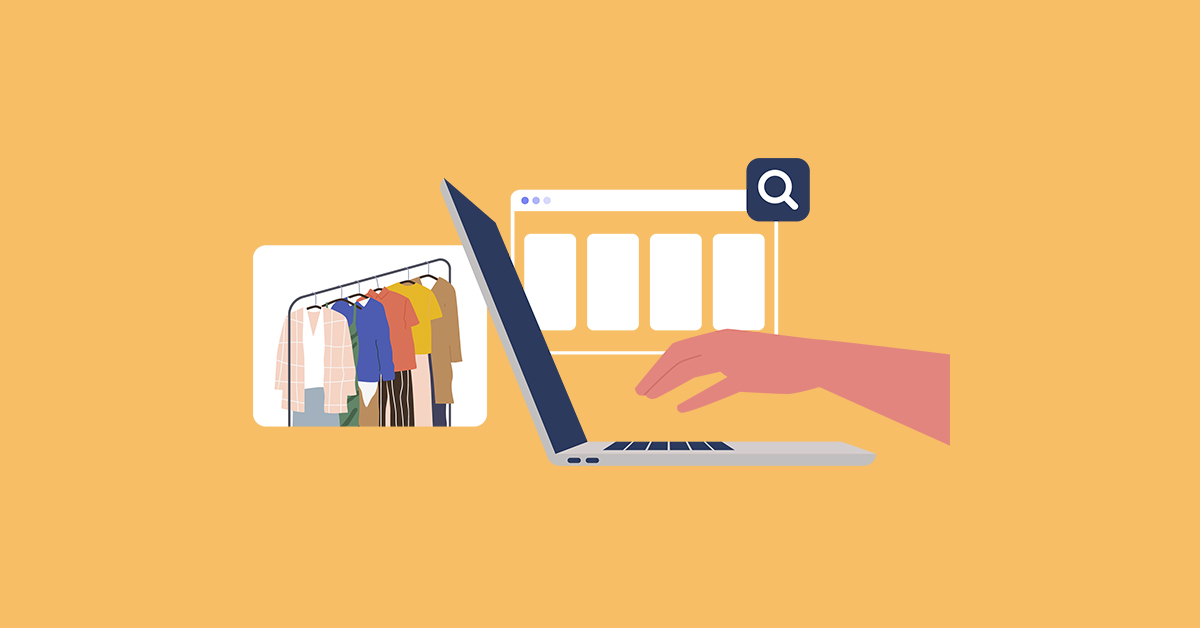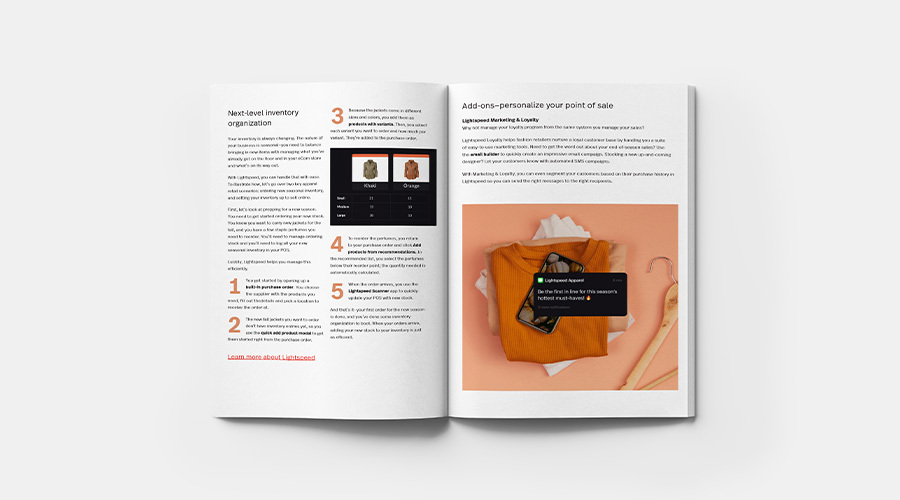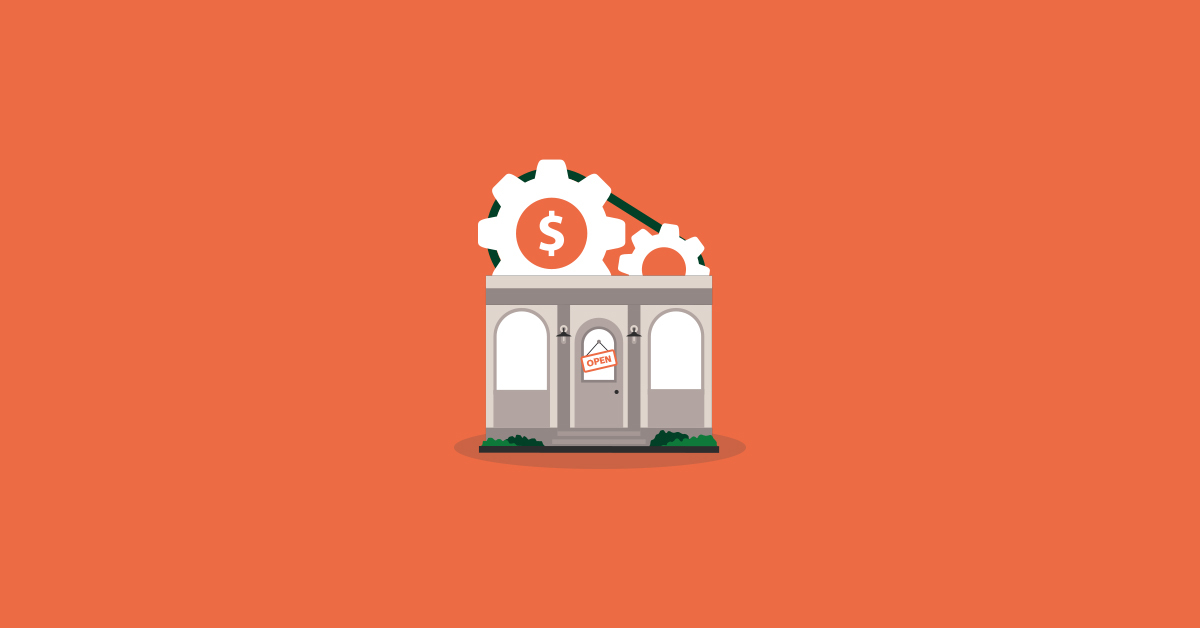
Running an online clothing boutique is a great way to have a retail business without taking on the overhead of a traditional brick-and-mortar operation. However, unless you plan on manufacturing your own stock, you’ll need to source your online boutique inventory from wholesalers and other creators. We’ll show you how to do just that in this guide on how to get inventory for your online boutique.
Here’s a look at the specifics of what we’ll cover:
- Where to buy clothing wholesale
- How to vet suppliers
- How to store and organize your inventory
- How to set prices
The Ultimate Clothing Boutique Guide
From managing always-evolving inventory to making personal connections during sales, your clothing store needs tools that help you do it all.

How to get inventory for an online boutique: Where to buy clothing wholesale
If you want to know how to start an online boutique, one of the first things you’ll need to do after writing your clothing store business plan is source inventory.
You have six primary routes you can take to get inventory for your online boutique:
- Attending trade shows
- Working with online wholesale suppliers
- Working directly with manufacturers
- Visiting offline wholesalers
- Using wholesale directories
- Reselling used goods
1. Wholesale boutique clothing trade shows
Attending a trade show is a great way to get inventory for an online boutique.
A trade show is an exhibition where suppliers showcase their latest products—in apparel retail, their latest lines and designs—for industry professionals and consumers. Some shows are open to the public, but many require you to be a representative of a company to attend.
- Pros: working with wholesalers can help you get products to market faster than manufacturing your own, and by visiting a trade show, you can test the quality of products in person. You can also start building up the crucial relationships required to consistently buy wholesale by interfacing with supplier representatives in person.
- Cons: while there are different trade shows happening around the world throughout the year, each individual trade show is only open for a short amount of time. That means if you need to buy inventory for your online boutique and there isn’t a trade show happening near you in the near future, you’ll need to pay out of pocket for travel costs.
Keep in mind that as most trade shows require you to prove that you’re a fashion buyer, you’ll need to be prepared to upload a business card or share your job title and business name upon registration.
Some of the most popular trade shows for wholesale boutique clothing are:
- Agenda – Hosted in Las Vegas twice a year and featuring more than 1,000 brands, Agenda specializes in exhibiting streetwear and providing an educational and supportive community to designers and buyers.
- American Handcrafted – For boutique owners looking to source handcrafted clothing, accessories, and gifts, attending American Handcraft in Philadelphia is a must.
- COAST – COAST is Miami’s premiere fashion trade show and is held four times a year. This juried show features a curated collection of established and emerging designers.
- COTERIE – This show connects the best brands in women’s fashion, including apparel, accessories and footwear, with buyers from around the world in New York City and online. COTERIE also has an annual show dedicated to swimwear and resort wear in Miami.
- Designers & Agents – Designers & Agents showcases a curated selection of 300 designers every season in New York and Los Angeles.
- MAGIC – This wholesale trade show specializes in exhibiting the latest trends in contemporary clothing for women and men. They have shows several times a year in different locations across the United States, including New York City, Las Vegas and Nashville.
- Pure London – This London-based fashion trade show showcases womenswear, menswear and kidswear brands twice a year.
2. Wholesale clothing websites
If traveling to a trade show isn’t an option for you, you can also source online boutique inventory via wholesale boutique clothing websites. These are ecommerce sites that specialize in selling in bulk to businesses instead of to customers, and so tend to have much higher minimum orders than the average customer would want.
Purchasing inventory online will be more hit or miss than attending trade shows because you won’t know the quality of the items until you receive them. To mitigate disappointment, see if the wholesalers offer samples.
- Pros: online wholesale marketplaces offer a wider range than trade shows—if you want to sell it, someone online probably has it. You also don’t need to travel to attend shows and can buy inventory for your online boutique whenever you need it. Like in-person trade shows, online wholesale clothing stores will likely be faster than making your own, and you can often get the best prices online.
- Cons: Purchasing inventory online will be more hit or miss than attending trade shows because, unless the wholesaler or marketplace carefully curates their brands, you won’t know the quality of the items until you receive them, and there are a number of scam sites out there you need to avoid. To mitigate disappointment, see if the wholesalers offer samples.
Just like with trade shows, you’ll probably need to prove that you’re a fashion buyer to gain access to wholesale inventory and pricing.
Check out these wholesale boutique clothing websites to get started:
- NuOrder by Lightspeed – NuOrder is a wholesale buying platform with both free and paid plans to help you buy from curated brands you know you can trust. Womenswear, menswear, kidswear, home goods, accessories and beauty products are all available for a wide selection.
- LA Showroom – This online wholesaler sells a wide variety of womenswear, menswear, kidswear, footwear, beauty products and accessories.
- FashionGo – FashionGo is a well-established site that offers everything from kidswear and fragrances to women’s fashions.
- Magnolia Fashion Wholesale – This Miami-based wholesaler specializes in contemporary womenswear and offers shipping to 80 countries.
- LuxiSoCool – LuxiSoCool offers wholesale fashion packs curated by their in-house stylists, so you can get a selection of coordinated styles for your chosen demographic.
3. Work with manufacturers
Instead of working with wholesalers—or in addition—you can work directly with manufacturers to get inventory for your online boutique. You can either buy pre-made goods directly from them, cutting out the wholesaler middleman, or you can order custom inventory for your online boutique.
- Pros: cutting out the wholesaler middleman can lower inventory acquisitions costs. If you decide to make custom merchandise with a manufacturer, you’ll have unique stock no one else is carrying.
- Cons: wholesalers exist for a reason. You might find trying to work directly with manufacturers difficult. They generally specialize in creating products, not selling them, and so not all manufacturers are willing to sell directly to retailers (or have an easy way for you to order). For manufacturers that do wholesale their own products, you’ll run into the same relationship barriers as regular wholesaling. If you’re ordering custom products, you’ll need to budget design and sample costs.
If you find products you like at other online shops, look for a manufacturer or brand name in the product description. Then, research the brand and, if possible, contact them directly to see if they offer wholesale pricing.
4. Offline wholesale clothing vendors
Offline wholesalers are a lot like trade shows, but they’re open all year. They function similarly to trade shows—you’ll go to test quality in person and make connections face to face. If you live near one, consider visiting regularly for your online boutique inventory.
- Pros: all the benefits of trade shows, but open all year. That means you can fit visits into your schedule as needed.
- Con: if you’re not in a major market area for a year-round wholesale market, you’ll still need to pay travel costs to go to one. Also, not all suppliers exhibit all year at fixed markets.
Some of the biggest offline wholesale vendor markets include:
- AmericasMart Atlanta – Claims to be the world’s largest collection of wholesale gift, decor and apparel showrooms. Has both permanent showrooms and rotating speciality markets.
- Dallas Market Center – Another large market with both permanent showrooms and rotating speciality markets. In addition to apparel and accessories, you can find housewares, gifts, jewelry and childrens’ goods.
5. Wholesaler directories
Trade literature in the fashion retail world is typically regular publishings of catalogs and directories of wholesalers. Traditionally, these were printed magazines; nowadays, many have moved their operations online. They can be updated weekly, monthly, quarterly or yearly.
- Pros: you can browse the catalogs at your leisure, in your own home or office. They’re full of vetted suppliers you know you can trust for your online boutique inventory.
- Cons: you’ll often need to pay a fee to subscribe to these catalogs and directories. As you typically can’t order from them directly, you’ll still need to do the work to build up the relationship with the wholesalers you find in them.
If you want to browse trade catalogs and directories, you could try:
- Worldwide Brands – an online directory of wholesalers who work with ecommerce retailers. There’s a one-time fee to sign up, after which you get lifetime access to their vetted suppliers (updated weekly).
- Wholesale Central – a free directory of trusted suppliers with links to their sites for purchasing.
6. Fashion resale
Wholesalers are the most common way to get inventory for online boutiques—but they’re not the only way. Fashion resale (thrifting and vintage) is on the rise, and could be an angle you consider for your clothing store.
- Pros: you’ll have a wholly unique inventory that’s attractive to a dedicated subset of customers.
- Cons: sourcing high quality clothing for resale can be far more difficult than working with wholesalers, and may include long hours networking at yard sales and estate sales. You still need to make connections, but this time with individuals instead of companies. Taking donations for online boutique inventory can be a little more complicated than for a brick-and-mortar thrift store; who pays shipping? What do you do with clothing you don’t want to sell?
How to vet wholesale suppliers
Investing in inventory with a new supplier can feel intimidating. Take these measures to ensure you’re working with trustworthy wholesalers and manufacturers:
- Ask the supplier for references, then contact the references and ask them how they like working with the supplier.
- Find out if you’ll be working with a dedicated sales representative. If not, your requests may slip under the radar.
- Pay attention to the sales rep’s communication style and responsiveness. If they take days to respond to an email and don’t have the answers you need, then you’ll probably have a frustrating working relationship. If they respond promptly and are organized, then you could be looking at the beginning of a mutually beneficial partnership.
- If possible, visit the supplier’s warehouse or ask for samples. While in the warehouse, observe how organized the inventory is. Feel the products and test for quality.
For more tips, check out our guide on how to buy wholesale.
How to store and organize your inventory
Once you’ve got your inventory, you need to organize it so you can sell it without wasting hours on extra admin tasks. Here are a few pointers that will help you organize, store and ship your inventory to make your life easier, and keep your customers happy.
1. Organizing your boutique’s inventory
The key to well-organized inventory is creating a system and using software to keep track of stock, sizes, stock-keeping units (SKUs), sales and more.
When you use a retail POS that has an ecommerce component, like Lightspeed, you can easily upload your inventory into a centralized dashboard. Whenever you make a sale, quantities are automatically updated and you’re notified, so that you can jump to the fulfillment process.
2. Storing your online boutique’s inventory
The benefit of running an online boutique is that you don’t need to rent a storefront. If possible, begin your business by storing your inventory at home. When you grow out of your space, consider renting out a warehouse or storage unit.
You’ll need shelves and bins for at-home storage. Look for clear bins that close, so that you can easily see your inventory and prevent them from getting damaged, wet or mildewy. Consider adding odor-eliminators to your bins to keep your inventory fresh.
Create a labeling system for your bins and items. Add SKUs to your ecommerce software and add these labels to your inventory to make them easy to find.
It’s important to stay organized. You can develop your own storage system, or look for inspiration from around the web. YouTube is a great resource for inventory storage systems. Check out this video from Empty Hanger for one example of an at-home storage system, or this video from Jenna Jade for another example of a low-cost, simple storage system.
3. Shipping inventory
When a customer makes a purchase, your ecommerce software will notify you. Then it’s time to package and ship the order.
Keep shipping materials on hand. Stock up on poly mailers, boxes, tissue paper, plastic apparel sleeves and packing tape.
To save time at the post office, purchase a scale and shipping label printer. Look for fulfillment tools that integrate with your ecommerce software to import orders and print labels in bulk, and automatically send customers shipping notifications and tracking information.
How to set prices for your online boutique
There are several ways to set prices for your online boutique.
The first strategy, which is called the keystone markup, involved simply doubling the wholesale price. This strategy is used across the industry. However, it may not give you enough of a profit margin as it doesn’t take your costs (such as labor, shipping, marketing, software and discounts) into consideration.
The second method is to use the manufacturer’s suggested retail price (MSRP), which, as the name suggests, is the price that the manufacturer recommends you sell the item for. Some manufacturers mandate an MSRP, which doesn’t take your costs into account. Other manufacturers simply offer the MSRP as a suggestion, to help put their retailers on a level playing field.
The third strategy is to use the absorption pricing method, which involves adding up the costs incurred to run your business (including labor, marketing, software and the cost of your inventory), dividing it by the number of units purchased and adding your desired profit margin.
Wrapping up: How to get inventory for an online boutique
Creating an online boutique is an exciting opportunity to run a retail business without spending a ton on overhead.
Now that you understand how to get inventory for an online boutique, here’s a checklist to sum it all up:
- Buy clothing through one or several of the below methods:
- Trade shows
- Online wholesale sites
- Working directly with manufacturers
- Visiting offline wholesale markets
- Browsing wholesale directories
- Reselling fashion
- Vet suppliers by:
- Asking for and contacting references
- Finding out if you’ll be working with a dedicated sales representative
- Paying attention to the sales rep’s communication style and responsiveness
- Visiting the supplier’s warehouse and/or reviewing samples
- Store and organize inventory by:
- Using ecommerce software to organize your stock
- Creating a system to store your inventory
- Purchasing shipping supplies and using a fulfillment software that integrates with your ecommerce software to ship orders
- Set prices using one of the following methods:
- Keystone method
- MSRP
- Absorption pricing method
Looking for an ecommerce platform that can take your online boutique to the next level? Talk to us to learn about Lightspeed eCom.

News you care about. Tips you can use.
Everything your business needs to grow, delivered straight to your inbox.




